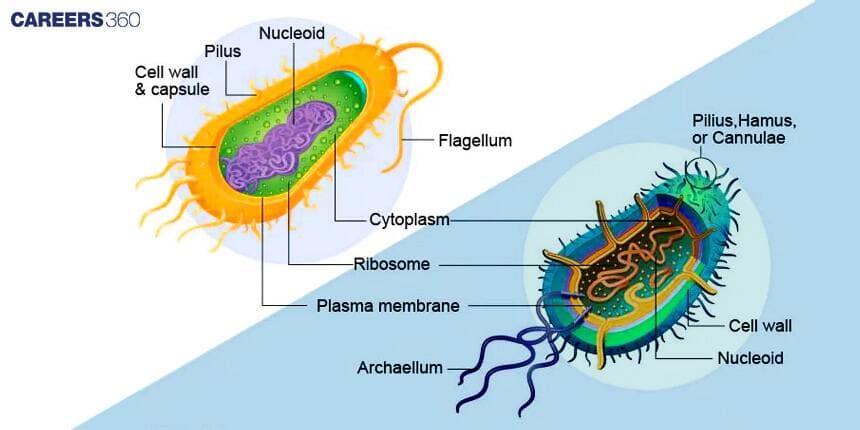Difference Between Archaea and Bacteria: Overview, Similarities & Differences
Bacteria and Archaea are two groups of prokaryotic microorganisms that, despite some similarities, differ significantly in their cellular structure, genetics, and ecological roles. The difference between Archaea and Bacteria lies primarily in their cell membrane composition, genetic makeup, and habitat adaptability. Archaea have unique lipids in their cell membranes and genes that allow them to thrive in extreme environments, such as high-temperature hot springs and highly acidic or saline areas. These are important topics from Biological Classification Biology class 11th.
Don't Miss: Most scoring concepts for NEET | NEET papers with solutions
NEET 2025: Syllabus | PYQs | Crack NEET in 2 months - Study Plan
NEET Important PYQ & Solutions: Physics | Chemistry | Biology | NEET PYQ's (2015-24)
- What are Archaea and Bacteria?
- What are Archaea?
- What are Bacteria?
- Difference between Archaea and Bacteria
- Genetic differences of Archaea and Bacteria

What are Archaea and Bacteria?
Bacteria and archaea are single-celled organisms called prokaryotes. Both of them are differentiated by structure, genetics, and metabolism. At the ecosystem level, they share decisive roles as decomposers, symbionts, and pathogens. Therefore, knowing the differences between Archaea and Bacteria is important for understanding kingdoms, evolutionary history, and ecological dynamics to identify their potential for biotechnology and medicine.
Also Read:
What are Archaea?
Archaea are small, single-celled microorganisms, one of the three domains of life, the other two being Bacteria and Eukaryotes. Its existence was discovered in the 1970s when initially, it was thought of as Bacteria since they are prokaryotic but later it was realised that it is a different group based on genetic and biochemical distinctions. Some of the basic points are discussed below:
It possesses a unique type of cell membrane lipid called ether-linked phospholipid, unlike the Bacteria that have ester-linked phospholipid.
These microorganisms are extremophile class, as they thrive in extreme environments that include hot springs, salt lakes, and deep-sea hydrothermal vents.
They show highly diverse metabolic pathways, for example, methanogenesis, production of methane and various extremophilic adaptations - for thermophiles or halophiles, for example.
Examples of Archaea
Some common examples are discussed below:
Methanogens: These occur in anaerobic environments like swamps and the guts of animals, and they excrete methane due to their metabolism.
Thermophiles: This is an extremophilic species that dwells in the higher temperatures that are found in hot springs and geothermal areas.
Halophiles: Grow well in salt-rich surroundings such as salt lakes and hypersaline.
What are Bacteria?
Bacteria are unicelled prokaryotic microorganisms that relate to the domain Bacteria. The first bacteria was discovered by Antonie van Leeuwenhoek in the 17th century. This laid the foundation for microbiology. Some of the basics are discussed below:
The cell wall of the bacterium is mainly composed of peptidoglycan.
Bacteria reproduce asexually by binary fission.
The metabolic pathways of bacteria are very diverse, including aerobic and anaerobic respiration, fermentation, and photosynthesis.
They exist everywhere in the environment: soil, water, and living tissues of organisms.
Examples of Bacteria
Escherichia coli, or E. coli: The bacterium is found in the intestines of humans and other animals. It has a role in digestion.
Staphylococcus aureus: This is a bacteria responsible for skin infection and, at times, serious diseases.
Cyanobacteria: The photosynthetic bacteria whose photosynthesis byproduct is oxygen. They have, in fact greatly, contributed to the Earth's Atmosphere and Aquatic Ecosystem.
Archaea and Bacteria Diagram
The diagram below shows the cells of Archaea and bacteria

Difference between Archaea and Bacteria
Some basic difference between Archae and bacteria is discussed below:
Feature | Archaea | Bacteria |
Cell Wall Composition | Cell walls lack peptidoglycan; composed of pseudopeptidoglycan or proteinaceous surface layers. | The cell walls of bacteria contain peptidoglycan, which is a polymer of altered sugars cross-linked by polypeptides. |
Membrane Lipids | Membrane lipids are ether-linked phospholipids, with isoprenoid side chains often branched. | Cell walls containing peptidoglycan which is a polymer of modified sugar cross-linked with short polypeptides. |
Flagella and Motility | Thinner flagella are composed of different proteins, they also have different mechanisms for motility. | Thicker flagella are made of flagellin protein; they utilise a rotary motor mechanism for motility. |
Genetic differences of Archaea and Bacteria
Archaea and Bacteria exhibit notable differences in their genetic and molecular processes:
Genomic Organisation
As with eukaryotes, introns are common in archaeal but not bacterial genomes.
Along with the chromatin structure of their DNA, which resembles that of eukaryotes, with histone-like proteins, rather than the other proteins that associate with bacterial DNA.
DNA Replication, Transcription, and Translation Differences
Archaea use a class of enzymes for replicating DNA that are eukaryotic-like; bacteria have their distinct replication machinery.
Transcription and translation apparatus in Archaea include evolutionarily unique RNA polymerases as well as ribosomal proteins in the Archaea concerning Bacteria.
RNA Polymerase Structure and Function
Archaeal RNA polymerases are more closely related to eukaryotic RNA polymerases than to bacterial RNA polymerases.
They exhibit differences in promoter recognition and transcription regulation compared to bacterial RNA polymerases.
Read more:
Frequently Asked Questions (FAQs)
The cell wall composition, membrane lipids, and genetic machinery are the major differences.
Archaea is mostly in extreme environments such as hot springs or salt lakes. Bacteria are found almost everywhere, soil, water, and inside other organisms.
So far, there have been no pathogenic Archaea identified. Many Bacteria, however, are known to cause diseases in humans, animals, and plants.
Since no other type of organism shows such extremity, archaea have developed very particular adaptations-like specialised enzymes or even different membrane lipids-to be able to survive at high temperatures, high acidity, or high salinity.
Archaea and Bacteria are differentiated by sequencing of the genes of ribosomal RNA, owing to specific staining methods, and by analysis of membrane lipids.
Also Read
30 Nov'24 12:23 PM
28 Nov'24 05:34 PM
25 Nov'24 05:18 PM
23 Nov'24 10:02 AM
22 Nov'24 01:59 PM
21 Nov'24 04:58 PM
16 Nov'24 01:58 PM
